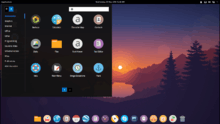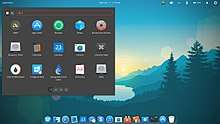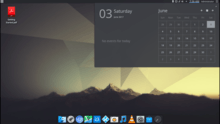BackSlash Linux
 | |
|
BackSlash Linux Olaf | |
| OS family | Linux |
|---|---|
| Working state | Current |
| Source model | Free Software with Open Source and Proprietary Components |
| Initial release | 2 November 2016 |
| Latest release | BackSlash Linux Olaf / 9 May 2017 |
| Marketing target | Personal computers |
| Available in | More than 55 languages by LoCos |
| Update method | APT, Discover Software Center |
| Package manager | dpkg |
| Platforms | AMD64 |
| Kernel type | Monolithic (Linux) |
| Default user interface | BackSlash Shell |
| License |
Free software license (Apache License) |
| Official website |
www |
BackSlash Linux is an Ubuntu and Debian-based Operating system developed in India for AMD64 and Intel x64 based Personal Computers. It is based on free software and every release of the Operating System is named after the characters of the Disney blockbuster, Frozen.[1] Since the third major release, BackSlash Linux Olaf, BackSlash Linux uses its own custom version of KDE, called the BackSlash Shell,[2] as the default user desktop.
Design[2]
BackSlash Linux's design is very hybrid.[3] It resembles macOS at the very first look with KDE at its bottom, but instead of being a KDE based distribution, it ships with many GNOME based applications. Also the buttons on the title bar resemble macOS but are arranged in a Windows like manner. The top bar resembles GNOME at the first look but after opening any App, it displays the Universal Menu Bar, looking similar to macOS or Unity.
Development
Development of BackSlash Linux was started in mid 2016. Being Ubuntu-based, it is compatible with its repositories ad packages and uses Discover Software Center to handle installation/removal of software. Its user interface aims at being intuitive for new users without consuming too many resources.
BackSlash Linux is based on Ubuntu's Long Term Support releases, which its developer actively maintains for bugs and security for years even as development continues on the next release.
Pre-release Versions
Three pre-release versions, codenamed as Alpha, Beta and Gamma were released before the first stable release. These were still available to download until May 2017 but now have been taken off from the website.
Anna

The first stable version of BackSlash Linux was BackSlash Linux Anna published on 02 November 2016 and based on Ubuntu 14.04. It ran on the Cinnamon Desktop Environment. The support and download option for this version is still available on BackSlash Linux's Website. An article was also published[4] on Linux.com introducing BackSlash Linux.
Elsa

The second release of BackSlash Linux was published on 20 December 2016 and was called BackSlash Linux Elsa. Elsa was built atop the Ubuntu "long-term support" release - Ubuntu 16.04 and ran on the flagship desktop environment of elementary OS, Pantheon. It added a lot of additional applications besides the core applications shipped with elementary OS[5] and replaced the Epiphany browser by Google Chrome. Many additional utilities like Skype, Wine, Deluge BitTorrent Client and Dictionary were also shipped out of the Box. Inclusion of GNOME Boxes for virtualisation of Desktops was another time-saver.
Olaf

BackSlash Linux Olaf is the third major and the current release of BackSlash Linux. It was published on 09 May 2017 and introduced 150+ new features over the last versions[6] of BackSlash Linux. It was based on Ubuntu 16.04 and ran BackSlash Shell - a customised KDE Desktop.[2] Due to it's heavily modified beautiful Desktop,[7] it gained much attention and received much praise than it's earlier versions.[3][8][9][7] This version of BackSlash Linux removed some of the applications to cut down the ISO size and also brought many refinements. Google Chrome was replaced by the Open-Source Chromium and Wine was upgraded to version 2.0.1.
Thunderbird was also included in this version for better email experience and the simple idea was to include the best apps available instead of KDE-specific apps.[9] This is the reason we see GNOME apps like Calendar, Disks, and Maps in this release.
BackSlash Linux Olaf also introduced a full-screen "AppLauncher" which resembled the "Launchpad" of macOS which was a fork of the discontinued application, "Slingshot".[10]
Reviewing BackSlash Linux Olaf, Souris from ProCambodian, said "For me I think this is the best build distro, it feels more complete and you don’t need much time to config it, cause’ everything is working out of the box."[8]
Version Summary table
| Codename | Release Date | Desktop Environment | Base |
|---|---|---|---|
| Alpha | N/A | Cinnamon | Ubuntu 14.04 LTS |
| Beta | N/A | Cinnamon | Ubuntu 14.04 LTS |
| Gamma | N/A | Cinnamon | Ubuntu 14.04 LTS |
| Anna | 2 November 2016 | Cinnamon | Ubuntu 14.04 LTS |
| Elsa | 20 December 2016 | Pantheon | Ubuntu 16.04 LTS |
| Olaf | 9 May 2017 | BackSlash Shell | Ubuntu 16.04 LTS |
Security
Security of BackSlash is based on Ubuntu and all the Security and Software updates are provided by Canonical by default, the programs run with standard user privileges, but administrator privileges are given whenever required. For increased security, the sudo tool is used to assign temporary privileges for performing administrative tasks, which allows the root account to remain locked and helps prevent inexperienced users from inadvertently making catastrophic system changes or opening security holes. Most network ports are closed by default to prevent hacking. A built-in firewall allows end-users who install network servers to control access. A GUI is available to configure it. BackSlash compiles its packages using GNU Compiler Collection features such as Position-independent code and buffer overflow protection to Hardening (computing) its software. BackSlash supports full disk encryption, as well as encryption of the home and Private directories.
Installation[11]
BackSlash Linux's installation is simple and is fully Graphical.[11][12] BackSlash Linux can be booted and run from a USB flash drive on any PC capable of booting from a USB drive, with the option of saving settings to the flash drive. A Ubuntu Live USB creator program is available to install an Ubuntu-based Distribution on a USB drive.
The Windows program "UNetbootin" allows BackSlash Linux USB burning.
Installation supports a Logical Volume Manager (LVM) with automatic partitioning only, and disk encryption. UTF-8, the default character encoding, supports a variety of non-Roman type Script (Unicode).
System Requirements[13]
- A x64 Intel or AMD64 Processor
- 2 GB Random Access memory
- 20 GB Hard disk drive Space (or USB flash drive Memory card or External Drive)
- Radeon, Intel HD and Iris Graphics or Nvidia Graphics processing unit with 256 MB Shared memory for Visual Effects
- Video Graphics Array Compatible Screen
- Either a Optical disc drive drive or a USB for the installer media
- Internet access is helpful for downloading updates while installing
Flavours and Server Edition
BackSlash Linux also released two official flavours - MATE and GNOME[14] and also a Server Edition[15] of the Operating System. Soon, the development and support for these versions (Flavous and Server Edition) was discontinued and the development was focused on the mainstream release.
References
- ↑ "BackSlash Linux - Free Operating System". www.backslashlinux.com. Retrieved 2017-07-29.
- 1 2 3 "Features - BackSlash Linux". www.backslashlinux.com. Retrieved 2017-07-29.
- 1 2 Linux Quest (2017-05-13), BackSlash Linux Olaf - KDE Hybrid Feel, retrieved 2017-07-28
- ↑ "BackSlash Linux - A new Cool Looking Distro in the Community". Linux.com | The source for Linux information. Retrieved 2017-07-28.
- ↑ "Would you recommend BackSlash Linux as an alternative to ElementaryOS? • r/elementaryos". reddit. Retrieved 2017-07-29.
- ↑ "Series olaf : BackSlash Linux". launchpad.net. Retrieved 2017-07-29.
- 1 2 Souris (2017-06-04), 5 Most Beautiful Linux Distro 2017, retrieved 2017-07-28
- 1 2 "BackSlash Linux Olaf Review - proCambodian". proCambodian. 2017-05-16. Retrieved 2017-07-28.
- 1 2 Planet Linux (2017-05-29), BackSlash Linux Olaf Review: Not Your Typical KDE Distro, In A Good Way, retrieved 2017-07-28
- ↑ Maverick Gaming (2017-05-09), Backslash Linux | A Beautiful Looking Distro, retrieved 2017-07-28
- 1 2 "How To Install BackSlash Linux Olaf". ribalinux.blogspot.in. Retrieved 2017-07-29.
- ↑ "How to install Backslash OS – Anna". www.linuxhelp.com. Retrieved 2017-07-29.
- ↑ "BackSlash Linux - Free Operating System". www.backslashlinux.com. Retrieved 2017-07-29.
- ↑ "timeline : BackSlash Linux". launchpad.net. Retrieved 2017-07-28.
- ↑ "BackSlash Linux - Browse Files at SourceForge.net". sourceforge.net. Retrieved 2017-07-29.
